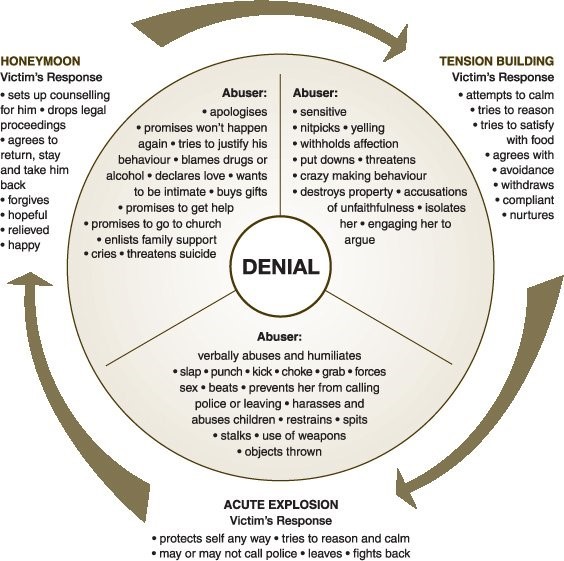The Cycle of Violence
Jun 28, 2019
People who have experienced domestic or family violence are often asked – “Why didn’t you just leave?”
There are many factors that cause people to stay in relationships that are abusive or violent, such as a fear of losing their children, concerns related to culture, religious beliefs, or finances, or a combination of these and/or other factors. Leaving a violent relationship is also the time when a victim is at most risk of increased violence. There are also emotional reasons that a person may stay with their abuser. The cycle of abuse explains why people stay in abusive relationships, by demonstrating how a perpetrators behaviour can change drastically from one day to the next. The cycle of violence theory was developed in 1979 by Dr Lenore Walker. It describes the stages that lead up to a violent incident, and the aftermath that leads victims to believe that it may not happen again.

Phase One – Tension-building Phase
- Build Up – A build up of tension in the relationship increases verbal, emotional or financial abuse. The abuser will become increasingly sensitive, put the victim down, yell or withhold affection. The victim will attempt to calm the abuser down, placate or reason with them, or withdraw and avoid the abuser.
- Standover – This phase can be very frightening for the person experiencing the abuse as they will feel they are walking on eggshells, and that the situation will explode if they do anything wrong. The abuser’s behaviour continues until a release of tension is inevitable.
Phase Two – Acute Explosion
- Peak of violence – In this phase the abuser may verbally, physically or sexually abuse the victim. The victim may try to protect themselves, reason with the abuser, fight back or leave. The abuser experiences a release of tension and as a result the behaviour can become habitual.
Phase Three – Honeymoon Stage
- Remorse – In this phase the abuser begins to feel remorse for his/her actions. They may withdraw or try to justify their actions to themselves and others by removing themselves from blame.
- Pursuit – In the pursuit phase the abuser will reach out to the victim, apologising and promising that the violence will not happen again. They may blame stress or drug and alcohol abuse for their behaviour. They will become caring and attentive, buying gifts and giving affection. The perpetrator might seem to have changed. The person experiencing the violence will feel hurt and confused, but also relieved that the violence is over and hopeful that it won’t happen again.
- Denial phase – Both people in the relationship can be in denial about the severity of the abuse and violence. They may become intimate again and want the relationship to continue. They may feel happy and not acknowledge that the violence could happen again. This phase may last for a short or long time before going through the tension building stage again.
If you recognise this cycle in your own relationship, and would like to talk to someone about it, you can reach out to SafeChoices here – Seek Help.
SafeChoices is a confidential service and can provide you with practical support, advice and referral to other services. We can give you information about your choices and help you to assess the right path for you and your children. Your safety is our priority.
* Image taken from White Ribbon
